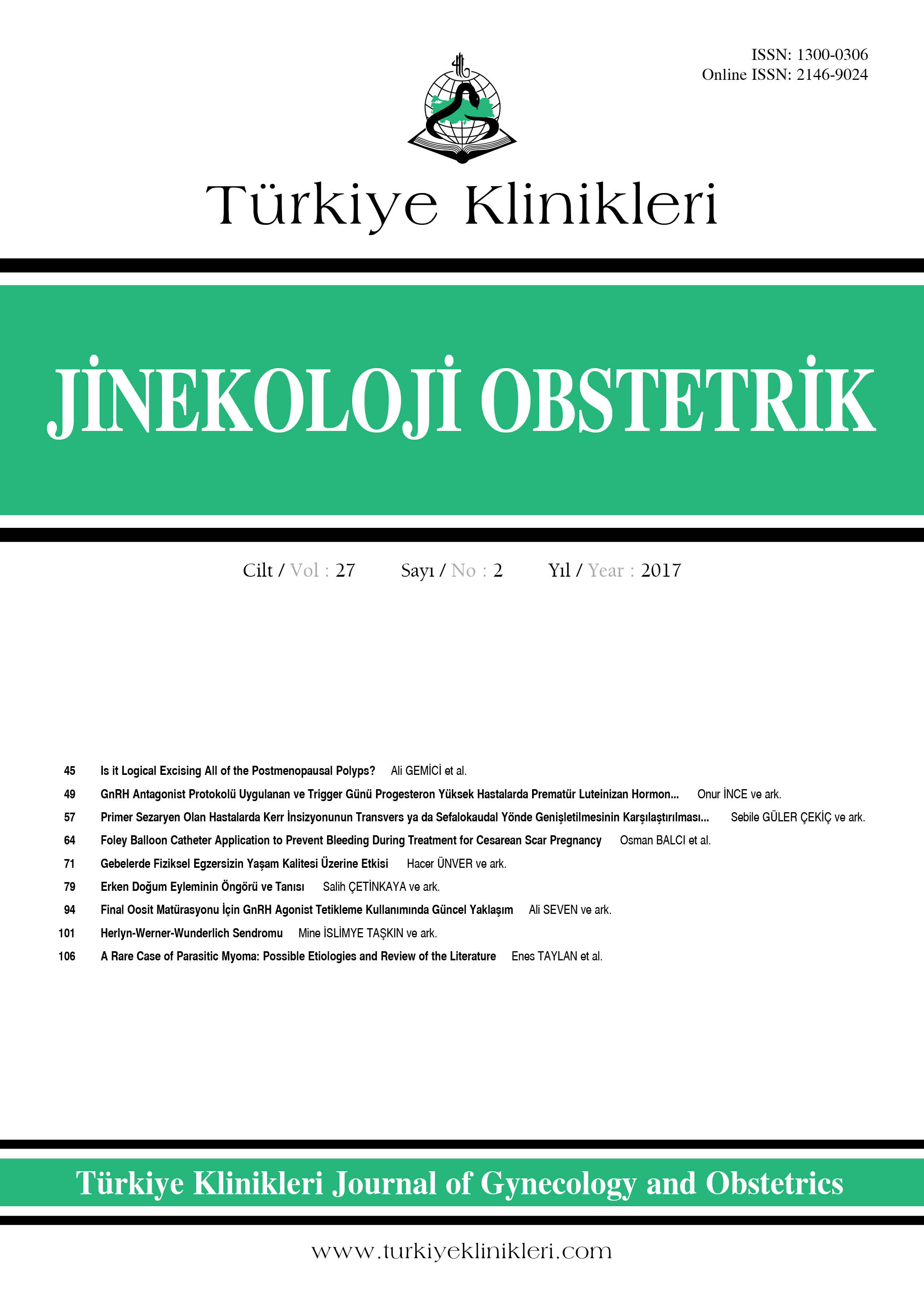Open Access
Peer Reviewed
ORIGINAL RESEARCH
2802 Viewed1373 Downloaded
Is it Logical Excising All of the Postmenopausal Polyps?
Postmenopozal Poliplerin Hepsini Eksize Etmek Mantıklı Bir Yaklaşım mı?
Turkiye Klinikleri J Gynecol Obst. 2017;27(2):45-8
DOI: 10.5336/gynobstet.2016-54030
Article Language: EN
Article Language: EN
Copyright Ⓒ 2025 by Türkiye Klinikleri. This is an open access article under the CC BY-NC-ND license (http://creativecommons.org/licenses/by-nc-nd/4.0/)
ABSTRACT
Objective: The aim of the present study was to address the question whether histologic evaluation is always necessary for women with a suspicion of an endometrial polyp at the postmenopausal period. Material and Methods: Between August 2007 and February 2014 a total of three hundred twenty seven postmenopausal women with a suspicion of endometrial polyp at the trans-vaginal ultrasound with or without a complaint of uterine bleeding were included to the study. Data were collected retrospectively from clinic records. All of the patients treated with hysteroscopy. Pathologic results were the main outcome measure. Results: Two cases of 158 asymptomatic polyps, 16 cases of 169 symptomatic polyps were malign and premalignant. The relative risk of symptomatic polyps is 1,79. The complication rate was 3,05% for all cases. At the symptomatic group 2 cases and at the asymptomatic group 8 cases have a complication. The complication rate was increased nearly by 4 times (p=0,027). Conclusion: Management strategies for postmenopausal endometrial polyps are controversial. In the light of our data, we suggest symptom-based interpretation for choosing management options. We believe that the management choice of an asymptomatic postmenopausal polyp is expectant instead of excision. Nevertheless, further work needs to be done more broadly to establish expectant management alternatives about the asymptomatic postmenopausal endometrial polyps.
Objective: The aim of the present study was to address the question whether histologic evaluation is always necessary for women with a suspicion of an endometrial polyp at the postmenopausal period. Material and Methods: Between August 2007 and February 2014 a total of three hundred twenty seven postmenopausal women with a suspicion of endometrial polyp at the trans-vaginal ultrasound with or without a complaint of uterine bleeding were included to the study. Data were collected retrospectively from clinic records. All of the patients treated with hysteroscopy. Pathologic results were the main outcome measure. Results: Two cases of 158 asymptomatic polyps, 16 cases of 169 symptomatic polyps were malign and premalignant. The relative risk of symptomatic polyps is 1,79. The complication rate was 3,05% for all cases. At the symptomatic group 2 cases and at the asymptomatic group 8 cases have a complication. The complication rate was increased nearly by 4 times (p=0,027). Conclusion: Management strategies for postmenopausal endometrial polyps are controversial. In the light of our data, we suggest symptom-based interpretation for choosing management options. We believe that the management choice of an asymptomatic postmenopausal polyp is expectant instead of excision. Nevertheless, further work needs to be done more broadly to establish expectant management alternatives about the asymptomatic postmenopausal endometrial polyps.
ÖZET
Amaç: Postmenopozal dönemde polip şüphesi olan her olguya histolojik örnekleme yapma gerekliliği var mıdır sorusuna cevap bulma amaçlandı. Gereç ve Yöntemler: Araştırmamıza Ağustos 2007-Temmuz 2014 tarihleri arasında postmenopozal endometrial polip ön tanısı ile Ankara Üniversitesi Tıp Fakültesi Kadın Hastalıkları ve Doğum Kliniğinde histeroskopik polip eksizyonu yapılan olgular dahil edildi. Toplamda 327 olgu semptom bazlı, uterin kanaması olanlar (semptomatik) ve olmayanlar (asemptomatik), olarak iki gruba ayrıldı. Veriler retrospektif olarak elde edildi. Patoloji sonuçları temel ölçüm verisi olarak değerlendirildi. Bulgular: Yüz elli sekiz asemptomatik olgu arasında 2 olguda, 169 semptomatik olgu arasında 16 olguda malign ve premalign patolojiler saptandı. Semptomatik poliplerin rölatif riski 1,79 olarak belirlendi. Olguların %3,05'inde komplikasyon ortaya çıktı. Asemptomatik grupta 2 olguda, semptomatik grupta 8 olguda komplikasyon ortaya çıktı. Semptomatik grupta komplikasyon oranı 4 kat fazla saptandı (p=0,027). Sonuç: Postmenopozal endometrial poliplerin yönetimi tartışmalıdır. Sonuçlarımız ışığında olguların semptom bazlı değerlendirilmesi ve tedavi yönetiminin bu prensipler çerçevesinde yapılması kanaatindeyiz. Asemptomatik poliplerin eksize edilmesinden ziyade takip edilmesi görüşünde olmakla beraber bu konu ile ilgili yapılacak geniş tabanlı prospektif çalışmalar yönetim stratejilerinin belirlenmesi hususunda daha aydınlatıcı olacaktır.
Amaç: Postmenopozal dönemde polip şüphesi olan her olguya histolojik örnekleme yapma gerekliliği var mıdır sorusuna cevap bulma amaçlandı. Gereç ve Yöntemler: Araştırmamıza Ağustos 2007-Temmuz 2014 tarihleri arasında postmenopozal endometrial polip ön tanısı ile Ankara Üniversitesi Tıp Fakültesi Kadın Hastalıkları ve Doğum Kliniğinde histeroskopik polip eksizyonu yapılan olgular dahil edildi. Toplamda 327 olgu semptom bazlı, uterin kanaması olanlar (semptomatik) ve olmayanlar (asemptomatik), olarak iki gruba ayrıldı. Veriler retrospektif olarak elde edildi. Patoloji sonuçları temel ölçüm verisi olarak değerlendirildi. Bulgular: Yüz elli sekiz asemptomatik olgu arasında 2 olguda, 169 semptomatik olgu arasında 16 olguda malign ve premalign patolojiler saptandı. Semptomatik poliplerin rölatif riski 1,79 olarak belirlendi. Olguların %3,05'inde komplikasyon ortaya çıktı. Asemptomatik grupta 2 olguda, semptomatik grupta 8 olguda komplikasyon ortaya çıktı. Semptomatik grupta komplikasyon oranı 4 kat fazla saptandı (p=0,027). Sonuç: Postmenopozal endometrial poliplerin yönetimi tartışmalıdır. Sonuçlarımız ışığında olguların semptom bazlı değerlendirilmesi ve tedavi yönetiminin bu prensipler çerçevesinde yapılması kanaatindeyiz. Asemptomatik poliplerin eksize edilmesinden ziyade takip edilmesi görüşünde olmakla beraber bu konu ile ilgili yapılacak geniş tabanlı prospektif çalışmalar yönetim stratejilerinin belirlenmesi hususunda daha aydınlatıcı olacaktır.
MENU
POPULAR ARTICLES
MOST DOWNLOADED ARTICLES





This journal is licensed under a Creative Commons Attribution-NonCommercial-NoDerivatives 4.0 International License.










